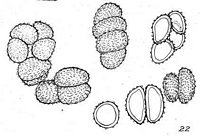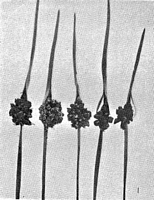|
 Tolyposporium neillii Tolyposporium neillii
SynonymsSorosporium neillii
BiostatusPresent in region - Indigenous. Endemic
Images (click to enlarge) | 
Caption: Plate 46 Fig. 1. Sorosporium neillii G.H. Cunn., in inflorescences of Scirpus nodosus
Rottb. Slightly infected specimens in the centre. All natural size. |
Article: Dingley, J.M. (1969). Records of plant diseases in New Zealand. New Zealand Department of Scientific and Industrial Research, Bulletin 192: 298 p. Wellington:.
Article: Cunningham, G.H. (1924). The Ustilagineae, or "smuts", of New Zealand. Transactions and Proceedings of the New Zealand Institute 55: 397-433 Wellington:.
Description: Sori in occasional ovaries, frequently in all, at first enclosed within the perigynium, becoming
exposed when black, compact, globose or elliptical, 3-4 mm. long. Spore-balls of 2-6 spores,
irregularly elliptical, dark chestnut-brown, up to 50 mmm. long, readily breaking up at
maturity. Spores irregular, angular, subglobose or elliptical, frequently flattened on one side,
12-20 X 9-15 mmm.; epispore coarsely and densely verrucose, chestnut-brown, 1-5-2. mmm.
thick.
Notes: The host is indigenous and abundant throughout; it occurs also in Australia, South Africa,
and South America (Cheeseman, 1.906, p. 776). Germination.- In water germination
commenced in three days; a short and slender probasidium is produced, and on this, both
laterally and terminally, conidia are produced. In certain specimens the terminal conidium is
formed before the probasidium becomes septate, but as a rule septation. precedes the
production of conidia.
This species differs from S. piluliformis (Berk.) McAlp., on Scirpus prolifer Rottb., in that
the spore-balls are less than half the size, are lighter in colour, and break up readily; the
spores are larger, and possess more verrucose, not tuberculate, epispores.
|